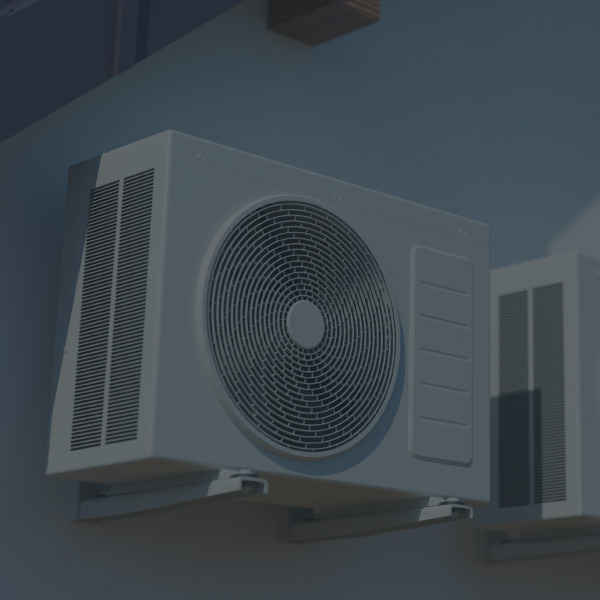CHAPTER 4: HOW TO GET OFF GAS
Heating
What is best for your home and what consumes the most energy?
Any appliances that heat or cool will use the most energy, which puts air conditioning units, home heating and ovens firmly in the frame. When it comes to heating, there are lots of questions to answer, and making the right choices can result in a warm home with low running costs and low environmental impact.
The two most popular and most energy-efficient fully installed electricity-based heating options are reverse-cycle air conditioning and hydronic heating. There are advantages and disadvantages to both, and either may suit some people, house designs and climates better than others, so which is best for you, and are there other options that should be explored?
There are other options such as resistive electric heaters, convection heaters, and hydronic which can be in panels attached to the interior walls, or in-floor water pipes.
Choice has a great Buyer’s Guide to choosing the best heat for your home.
Reverse-cycle air conditioners
Reverse-cycle air conditioners are the most efficient form of electric heating commonly available—indeed, their efficiency is usually of the order of several hundred per cent. They are now most often referred to as heat pumps, especially for systems installed primarily for heating. Technically, a heat pump is exactly that—it pumps or moves heat from one place to another. Because they source or sink their heat into the outside air, they are known as air-sourced heat pumps. Other examples include fridges and freezers, heat pump water heaters, and car air conditioners.
Heat pumps work by compressing a gas, called a refrigerant, which then transfers heat from one place to another. In your fridge, a heat pump transfers heat from inside the cabinet to outside, which is why the outside of the fridge gets warm. In a reverse-cycle air conditioner, the transfer can go either way, hence the name. In winter, heat is taken from outside and dumped inside, and in summer the opposite occurs. Instead of turning energy from one form (electricity) into another (heat), it uses electric energy to move heat from one place to another. Because heat is relatively easy to collect and move, heat pumps can move a lot more heat energy than the equivalent electric energy they use.
Dust is a great killer of heat pump efficiency—heat does not transfer well through dusty surfaces, so it’s important to reduce dust accumulation in both the indoor and outdoor units. Filters inside the air handling unit should be cleaned regularly, at least once a month if the unit is in regular use. Some systems are now “self-cleaning” or have filters that only need to be washed every six months, but they should still be checked regularly. Washable filters can usually just be washed with warm soapy water, rinsed and dried—just follow the manufacturer’s instructions.
Modern reverse cycle air conditioning systems are becoming more efficient over time, particularly in terms of energy consumption and cost, making them a very good investment in comfort and health. And as electricity prices continue to rise, air conditioner efficiency is becoming increasingly important. For example, one kWh of electricity consumed, will generate three or more kWh of heating or cooling.
Heat pump hydronic heating
The heart of a hydronic system is the water heating unit called the boiler, although the water never boils. The heated water flows through one or more pipe circuits to one or more radiators inside the home, which may be wall-mounted radiators or in-floor pipe coils, or both. These radiators emit warmth into the room. This means that even in very cold climates, there is a lot of heat energy available in our ambient environment. Heat pumps can change the temperature by concentrating this energy and shifting it around.
Many boiler systems, particularly heat pump systems, include a storage tank for thermal storage and to provide a buffer, which allows the boiler to run flat out and then turn off for a while, allowing the boiler to operate at maximum efficiency. However, some boilers are tankless in that there is no storage tank, although there is usually a small expansion tank to allow for expansion of the water as it heats.
The cleanest and most efficient boiler type is the heat pump. Most hydronic systems have multiple circuits to allow zoning, where you can heat all or only part of a home. This allows you to leave unused, closed-off rooms and areas unheated to reduce energy use—particularly useful in the shoulder months when heating the entire home is not necessary.
Hydronic heating systems use water to move heat from a source through piping to each room. It’s often installed in concrete slabs, secondary topping slabs, radiator panels & hydronic towel rails.
Water is circulated through the system using low-pressure circulation pumps, and circuits are turned on/off by electrically operated valves, usually controlled by an electronic controller. The controller includes timing capabilities to enable a system to heat certain parts of a home at certain times— for example, heating the living areas during the evening and the bedrooms just before bedtime.
Hydronic systems using under-floor coils or skirting radiators (long, narrow radiator panels that replace the regular skirting boards) provide warmth at floor level, so you get the feeling of warmth with lower ambient room temperatures than with space heating. An issue that only applies to in-slab hydronic systems is thermal lag. This is the time it takes from when you turn on the heating until you start to feel the warmth underfoot, or from when you turn the system off to when it cools down and stops heating the room. This occurs because of the high thermal mass of a concrete slab, which can take a considerable time to heat up or cool down.
Some hydronic systems, particularly those that have been retrofitted to homes and so don’t have in-floor coils, will use radiators that may be mounted near floor level. Some radiators are also mounted higher in a room, and some can do double duty. Some hydronic boilers are also designed to provide domestic hot water, eliminating the need (and cost) for a separate water heater.
The Energy Efficiency Council has put out a useful guide on Heat Pumps.

Resistive heating
Whenever an electric current flows through a material that has some resistance (i.e., anything but a superconductor), it creates heat. Electricity passes through the elements, which heat up due to their resistance to the current flowing through them. This form of heating can only ever be 100% efficient—the heat output equals the electrical energy input.
Radiant heaters
Heaters that work by radiating infrared are called radiant heaters, as you might expect. Radiant heaters are designed to heat you (and surfaces in the room) directly, much the way that sunlight feels warm. A common form of radiant heater is the glowing bar type heater, which uses a resistive wire coil wrapped around or sitting inside a ceramic rod or tube. These types of heaters are ideal for a quick burst of heat for a relatively short duration, although larger units can use a considerable amount of electricity. Unlike a heat pump, radiant heaters are exactly 100% efficient—all the electrical energy they consume is turned into heat.
The main advantages of high-temperature radiant heaters are the low purchase price, the rapid warm-up time and the lack of moving parts and hence high reliability. Radiant heaters can operate for many years with minimal maintenance, although replacement parts, particularly elements, are difficult to come by.
A slightly different form of radiant heat is the far infrared heater. They operate as a lower temperature as they emit longer wavelength infrared radiation than glowing bar heaters and similar high temperature radiant heaters. This long wavelength infrared heats you directly, and so produce a slow, gentle heat that warms you without you realising it. Most far infrared heaters are in the form of a flat panel or elongated strip.
Far infrared heaters are usually mounted on a wall or the ceiling, rather than being portable, so you must fit one in each room that you want heating in. This can become an expensive proposition compared to the more conventional radiant heaters, although still far cheaper than multiple reverse cycle air conditioners or a full hydronic system.
Another form of resistive radiant heating that runs at an even lower temperature is in-floor heating. This consists of resistive wire or plastic film which has the resistive element printed onto it. It can be laid under carpet or other floor coverings, where hydronic in-floor heating can’t be fitted. It is also far cheaper to install than hydronic heating (and there are even DIY versions available), although in some cases it may need a cement screed over the top before the floor covering is laid down. However, it is usually much more expensive to run than a heat pump hydronic system due to system efficiency being limited to 100%, like all resistive heating.
Resistive convection heaters
Convection heaters also uses resistive elements. But instead of emitting heat directly, the elements heat a flow of air drawn through the heater by a fan to become space heating. Because they are designed to heat all a room’s air, which can take quite a while, they take a lot longer to change the thermal comfort of a room than a radiant heater.
The limit for a typical convection heater (or any plug-in domestic electric heater) is 2300 W—the maximum you can draw from a power point. This means that resistive convection heaters will take a lot longer to heat a room than a heat pump, while using a lot more electricity in the process.
Some heaters combine both radiant and convection to give a quick feeling of warmth while slowly heating the room. The now common convective panel heaters come in both free-standing and wall-mounted units and are usually designed to be subtle and unobtrusive. A popular portable form of combined heater is the ‘oil’ heater, which uses electric elements to heat oil inside the heater, which circulates to distribute the heat to the outer surface of the heater, radiating heat while also heating the air.
A clever take on resistive convection heaters is the heat storage system. These heaters work by using cheap off-peak electricity, such as overnight or in the middle of the day when solar production is at a maximum, to heat a high thermal mass ceramic core. This heat can then be extracted later when needed. For example, you might use electricity billed on a cheap off-peak overnight tariff for heating the home in the morning, recharging the heater during the day from excess solar, ready for the evening peak when you arrive back home from work.
These heaters can store quite a bit of thermal energy. They can also release heat faster than they store it, so can provide rapid heating when needed. The main disadvantages with these heaters are that they are slow to respond when starting from cold, having to heat the ceramic core to a workable temperature (they are meant to run continuously at working temperature, at least during the colder months), and they are heavy units to install.












